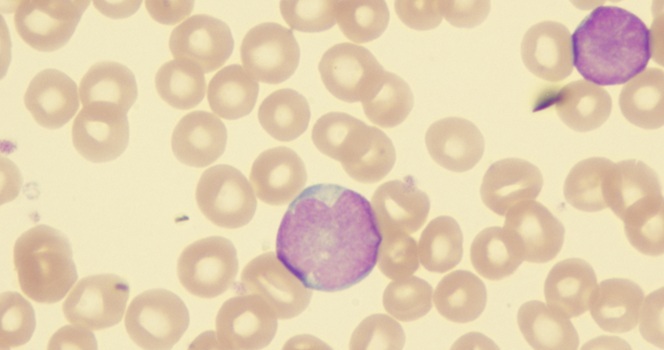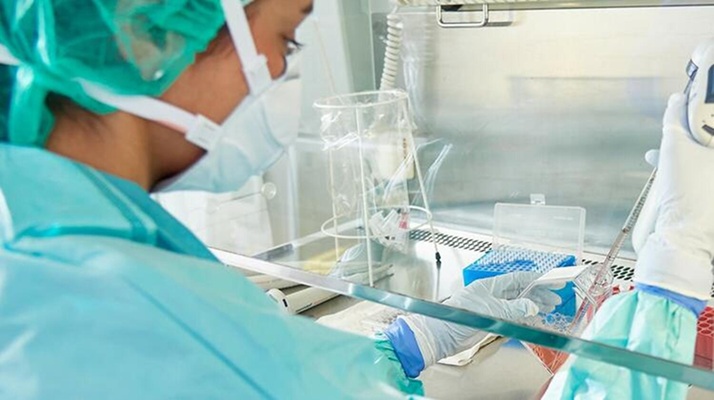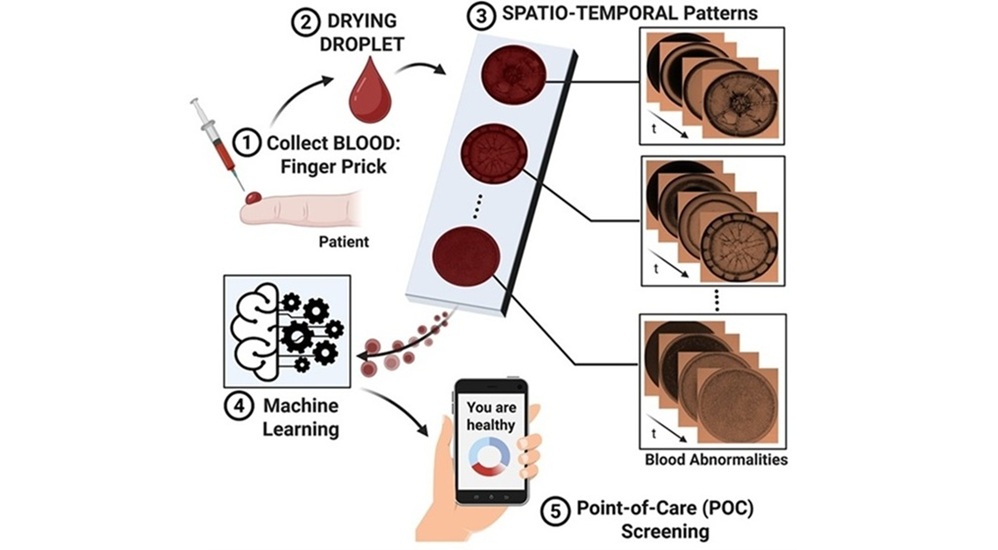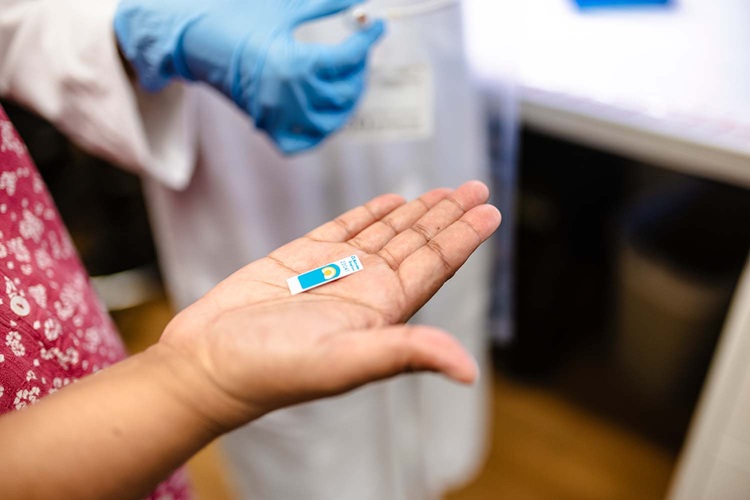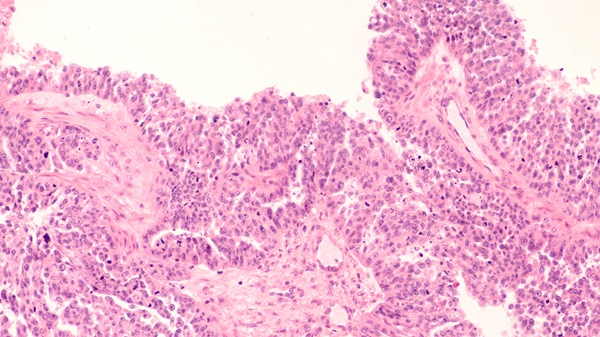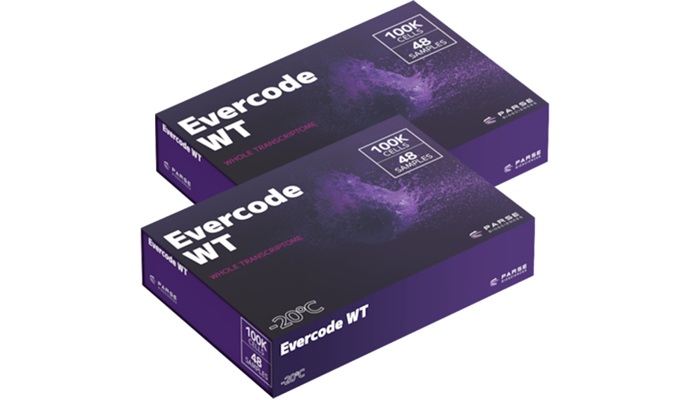Specific Cytokines Are Significant Biomarkers for AML
|
By LabMedica International staff writers Posted on 16 Oct 2019 |
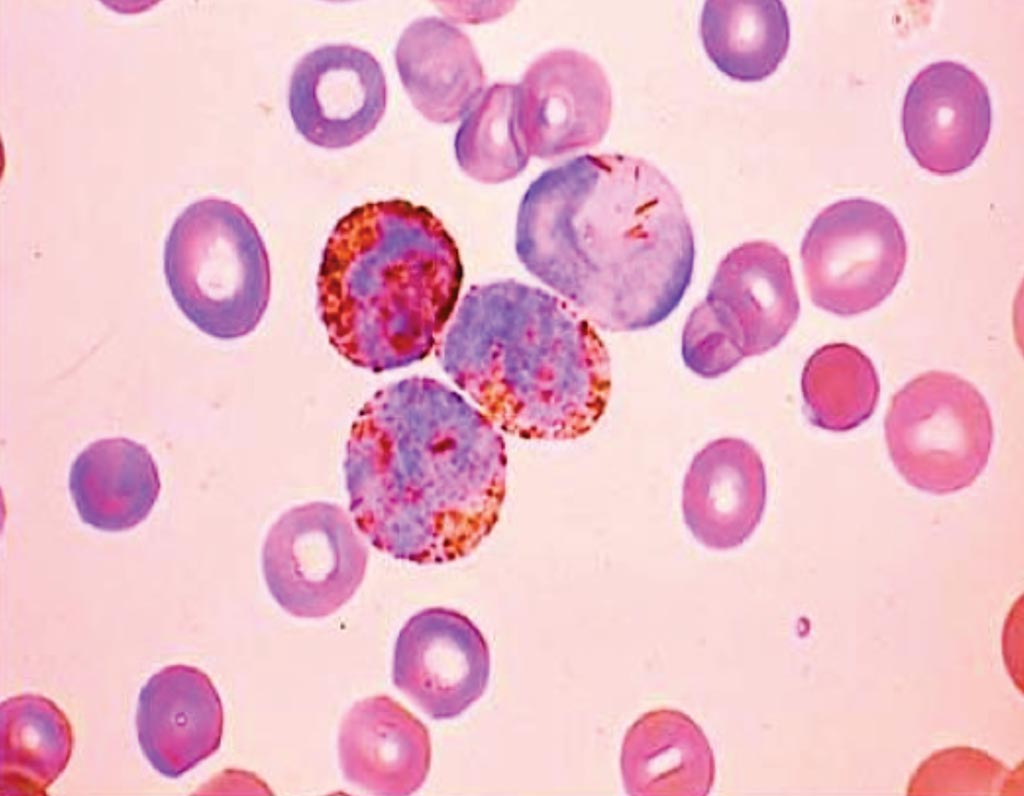
Image: Myeloperoxidase positive staining from a patient with acute myeloid leukemia (Photo courtesy of Monika Nema, MD).
Acute myeloid leukemia is a hematopoietic neoplasm derived from early progenitor myeloid cells; it is characterized by clonal expansion of myeloblasts, which are immature myeloid progenitors that accumulate in the bone marrow (BM).
Immune system impairment and immunetolerance were reported in patients with acute myeloid leukemia. T cells are the most active part of the immune system, nevertheless they were found to be functionally and numerically defective in acute myeloid leukemia. Interleukin-27 (IL27) and IL35 are regulatory T cells (T-regs) related cytokines; they may be involved in eukemogenesis of acute myeloid leukemia (AML).
Scientists at Sohag University (Sohag, Egypt) recruited 70 newly diagnosed patients with primary AML and 30 matched healthy volunteers. The diagnosis of AML in the patients was made using Leishman-stained peripheral blood smears; Bone marrow (BM) aspirates or occasionally trephine biopsy; Cytochemical staining of BM specimens using myeloperoxidase (MPO), esterase and periodic acid Schiff; and immunophenotyping (IPT): monoclonal antibodies (MoAb) used for staining of blast cells were labeled with fluorescein isothiocyanate, phycoerythrin.
Serum was obtained from plain blood sample tubes that were kept at −80 °C by centrifugation. Serum levels of IL-27 and IL-35 were measured by enzyme-linked immunosorbent assay (ELISA), for both patients and controls, using the commercially available kits. Absorbance was recorded at 495 nm, IL-27 assay range was 31.25–2,000 pg/mL, and IL-35 assay range was 15.63–1,000 pg/mL. The median age of the study patients was 36 years and the range was 18–80 years. Females comprised 52.9% of the patient group.
The scientists reported that significantly higher levels of IL27 and IL35 in AML patients compared with the control subjects, with median values of 77 and 51 pg/mL compared to 37 and 22.2 pg/mL, respectively. The correlations between serum levels of IL27 and IL3 in AML patients, revealed a significant positive correlation between IL27 with, white blood cell (WBCs) count, peripheral blasts percent and myeloperoxidase (MPO) positivity. However, IL35 levels showed a significant negative correlation with platelets count and significant positive correlations with age, CD45, HLA-DR and CD34.
The authors concluded that their study demonstrated that IL27 and IL35 could identify AML patients from healthy subjects, and their overexpression denotes poor prognosis. Based on the simplicity and wide availability of their detection technique they recommended the inclusion of IL27 and IL35 in the diagnostic/prognostic workup of AML. The study was published on October 1, 2019, in the Journal of Blood Medicine.
Related Links:
Sohag University
Immune system impairment and immunetolerance were reported in patients with acute myeloid leukemia. T cells are the most active part of the immune system, nevertheless they were found to be functionally and numerically defective in acute myeloid leukemia. Interleukin-27 (IL27) and IL35 are regulatory T cells (T-regs) related cytokines; they may be involved in eukemogenesis of acute myeloid leukemia (AML).
Scientists at Sohag University (Sohag, Egypt) recruited 70 newly diagnosed patients with primary AML and 30 matched healthy volunteers. The diagnosis of AML in the patients was made using Leishman-stained peripheral blood smears; Bone marrow (BM) aspirates or occasionally trephine biopsy; Cytochemical staining of BM specimens using myeloperoxidase (MPO), esterase and periodic acid Schiff; and immunophenotyping (IPT): monoclonal antibodies (MoAb) used for staining of blast cells were labeled with fluorescein isothiocyanate, phycoerythrin.
Serum was obtained from plain blood sample tubes that were kept at −80 °C by centrifugation. Serum levels of IL-27 and IL-35 were measured by enzyme-linked immunosorbent assay (ELISA), for both patients and controls, using the commercially available kits. Absorbance was recorded at 495 nm, IL-27 assay range was 31.25–2,000 pg/mL, and IL-35 assay range was 15.63–1,000 pg/mL. The median age of the study patients was 36 years and the range was 18–80 years. Females comprised 52.9% of the patient group.
The scientists reported that significantly higher levels of IL27 and IL35 in AML patients compared with the control subjects, with median values of 77 and 51 pg/mL compared to 37 and 22.2 pg/mL, respectively. The correlations between serum levels of IL27 and IL3 in AML patients, revealed a significant positive correlation between IL27 with, white blood cell (WBCs) count, peripheral blasts percent and myeloperoxidase (MPO) positivity. However, IL35 levels showed a significant negative correlation with platelets count and significant positive correlations with age, CD45, HLA-DR and CD34.
The authors concluded that their study demonstrated that IL27 and IL35 could identify AML patients from healthy subjects, and their overexpression denotes poor prognosis. Based on the simplicity and wide availability of their detection technique they recommended the inclusion of IL27 and IL35 in the diagnostic/prognostic workup of AML. The study was published on October 1, 2019, in the Journal of Blood Medicine.
Related Links:
Sohag University
Latest Hematology News
- Platelet Activity Blood Test in Middle Age Could Identify Early Alzheimer’s Risk
- Microvesicles Measurement Could Detect Vascular Injury in Sickle Cell Disease Patients
- ADLM’s New Coagulation Testing Guidance to Improve Care for Patients on Blood Thinners
- Viscoelastic Testing Could Improve Treatment of Maternal Hemorrhage
- Pioneering Model Measures Radiation Exposure in Blood for Precise Cancer Treatments
- Platelets Could Improve Early and Minimally Invasive Detection of Cancer
- Portable and Disposable Device Obtains Platelet-Rich Plasma Without Complex Equipment
- Disposable Cartridge-Based Test Delivers Rapid and Accurate CBC Results
- First Point-of-Care Heparin Monitoring Test Provides Results in Under 15 Minutes

- New Scoring System Predicts Risk of Developing Cancer from Common Blood Disorder
- Non-Invasive Prenatal Test for Fetal RhD Status Demonstrates 100% Accuracy
- WBC Count Could Predict Severity of COVID-19 Symptoms
- New Platelet Counting Technology to Help Labs Prevent Diagnosis Errors
- Streamlined Approach to Testing for Heparin-Induced Thrombocytopenia Improves Diagnostic Accuracy
- POC Hemostasis System Could Help Prevent Maternal Deaths
- New Test Assesses Oxygen Delivering Ability of Red Blood Cells by Measuring Their Shape
Channels
Clinical Chemistry
view channel
Chemical Imaging Probe Could Track and Treat Prostate Cancer
Prostate cancer remains a leading cause of illness and death among men, with many patients eventually developing resistance to standard hormone-blocking therapies. These drugs often lose effectiveness... Read more
Mismatch Between Two Common Kidney Function Tests Indicates Serious Health Problems
Creatinine has long been the standard for measuring kidney filtration, while cystatin C — a protein produced by all human cells — has been recommended as a complementary marker because it is influenced... Read moreMolecular Diagnostics
view channel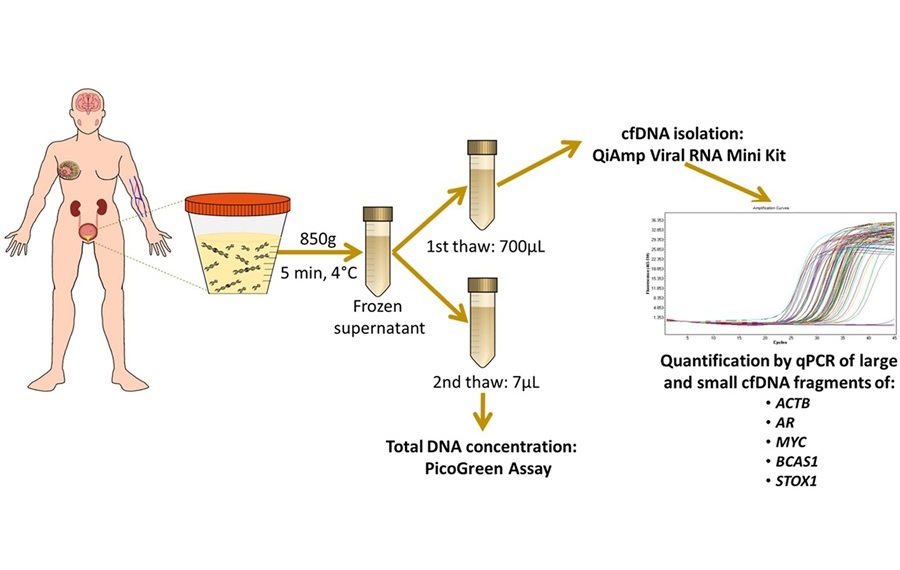
Simple Urine Test to Revolutionize Bladder Cancer Diagnosis and Treatment
Bladder cancer is one of the most common and deadly urological cancers and is marked by a high rate of recurrence. Diagnosis and follow-up still rely heavily on invasive cystoscopy or urine cytology, which... Read more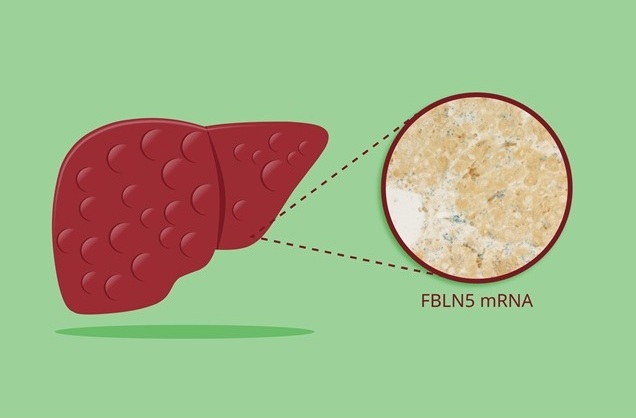
Blood Test to Enable Earlier and Simpler Detection of Liver Fibrosis
Persistent liver damage caused by alcohol misuse or viral infections can trigger liver fibrosis, a condition in which healthy tissue is gradually replaced by collagen fibers. Even after successful treatment... Read moreHematology
view channel
Platelet Activity Blood Test in Middle Age Could Identify Early Alzheimer’s Risk
Early detection of Alzheimer’s disease remains one of the biggest unmet needs in neurology, particularly because the biological changes underlying the disorder begin decades before memory symptoms appear.... Read more
Microvesicles Measurement Could Detect Vascular Injury in Sickle Cell Disease Patients
Assessing disease severity in sickle cell disease (SCD) remains challenging, especially when trying to predict hemolysis, vascular injury, and risk of complications such as vaso-occlusive crises.... Read more
ADLM’s New Coagulation Testing Guidance to Improve Care for Patients on Blood Thinners
Direct oral anticoagulants (DOACs) are one of the most common types of blood thinners. Patients take them to prevent a host of complications that could arise from blood clotting, including stroke, deep... Read moreMicrobiology
view channel
Rapid Diagnostic Test Matches Gold Standard for Sepsis Detection
Sepsis kills 11 million people worldwide every year and generates massive healthcare costs. In the USA and Europe alone, sepsis accounts for USD 100 billion in annual hospitalization expenses.... Read moreRapid POC Tuberculosis Test Provides Results Within 15 Minutes
Tuberculosis remains one of the world’s deadliest infectious diseases, and reducing new cases depends on identifying individuals with latent infection before it progresses. Current diagnostic tools often... Read more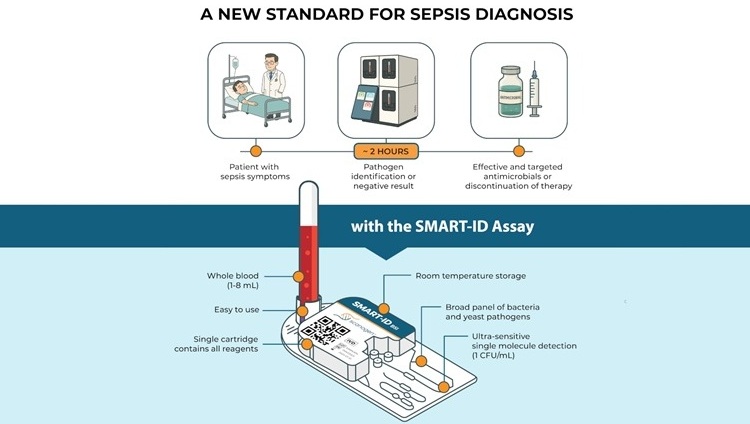
Rapid Assay Identifies Bloodstream Infection Pathogens Directly from Patient Samples
Bloodstream infections in sepsis progress quickly and demand rapid, precise diagnosis. Current blood-culture methods often take one to five days to identify the pathogen, leaving clinicians to treat blindly... Read morePathology
view channel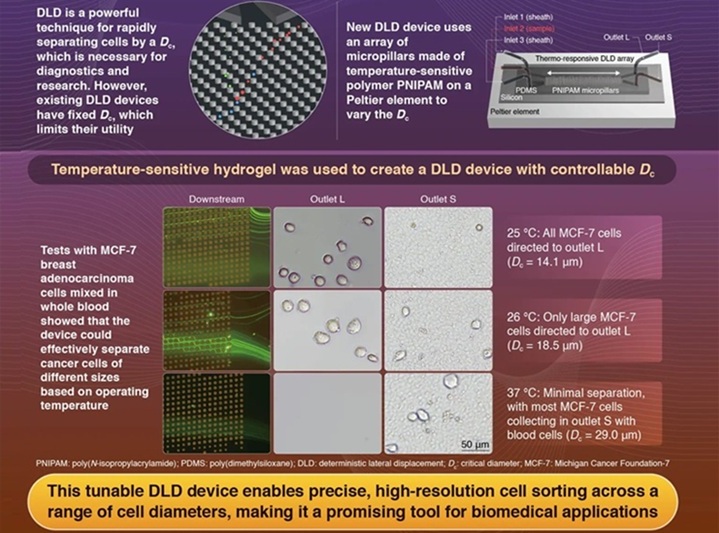
Tunable Cell-Sorting Device Holds Potential for Multiple Biomedical Applications
Isolating rare cancer cells from blood is essential for diagnosing metastasis and guiding treatment decisions, but remains technically challenging. Many existing techniques struggle to balance accuracy,... Read moreAI Tool Outperforms Doctors in Spotting Blood Cell Abnormalities
Diagnosing blood disorders depends on recognizing subtle abnormalities in cell size, shape, and structure, yet this process is slow, subjective, and requires years of expert training. Even specialists... Read moreTechnology
view channel
Artificial Intelligence Model Could Accelerate Rare Disease Diagnosis
Identifying which genetic variants actually cause disease remains one of the biggest challenges in genomic medicine. Each person carries tens of thousands of DNA changes, yet only a few meaningfully alter... Read more
AI Saliva Sensor Enables Early Detection of Head and Neck Cancer
Early detection of head and neck cancer remains difficult because the disease produces few or no symptoms in its earliest stages, and lesions often lie deep within the head or neck, where biopsy or endoscopy... Read moreIndustry
view channel
Abbott Acquires Cancer-Screening Company Exact Sciences
Abbott (Abbott Park, IL, USA) has entered into a definitive agreement to acquire Exact Sciences (Madison, WI, USA), enabling it to enter and lead in fast-growing cancer diagnostics segments.... Read more













